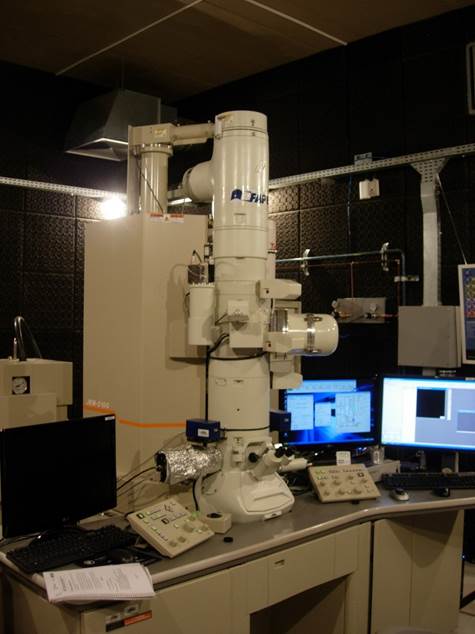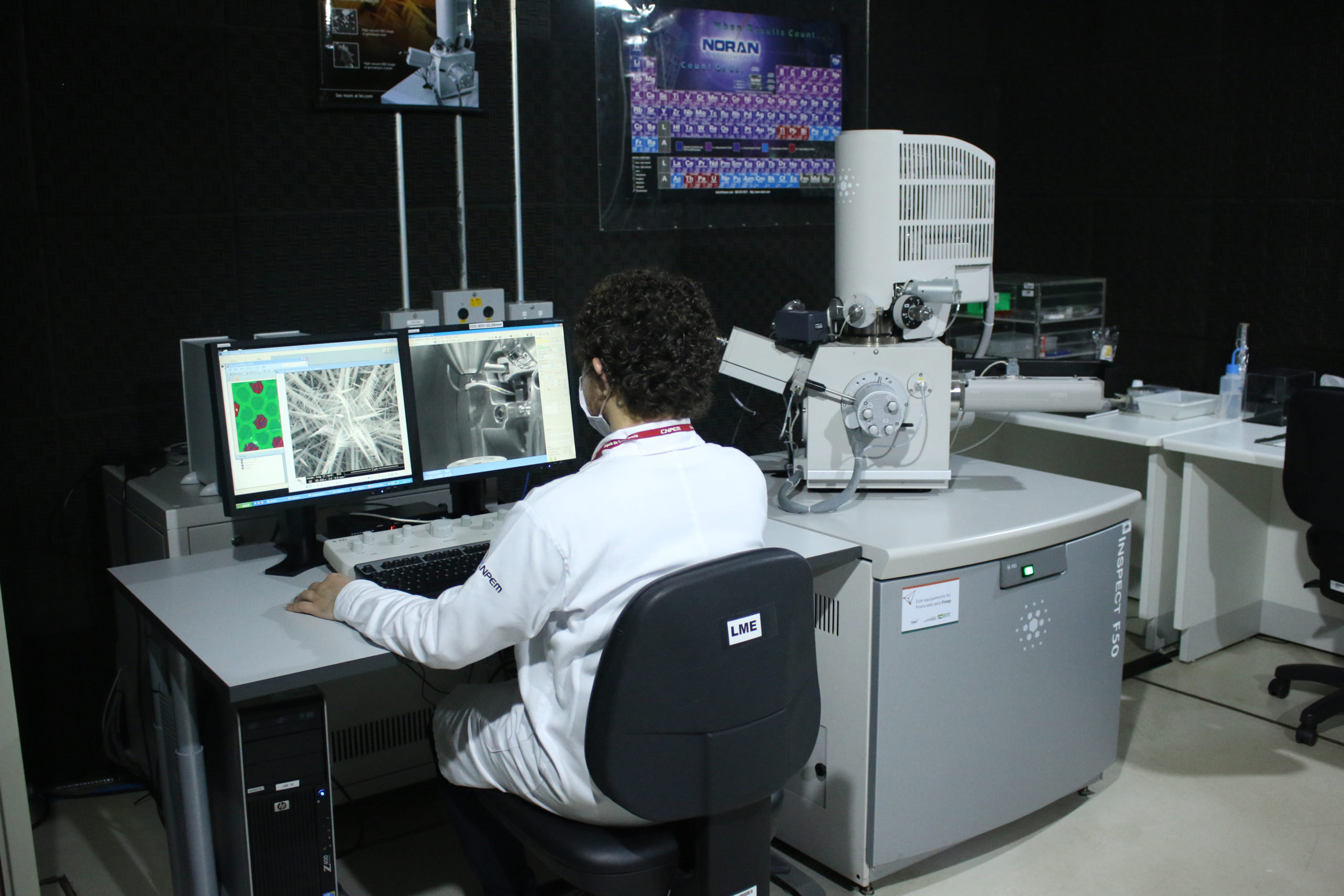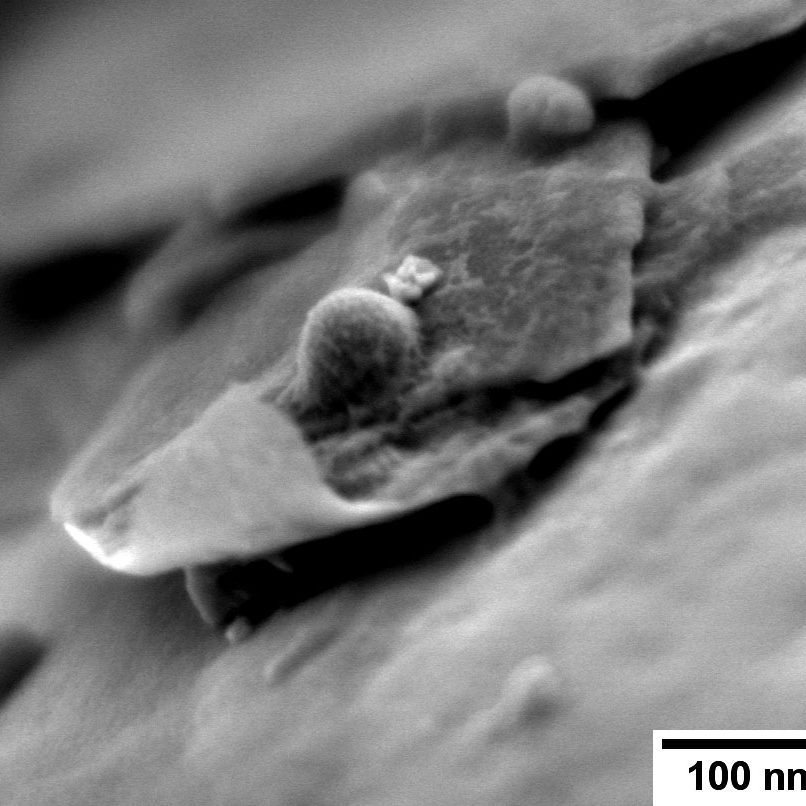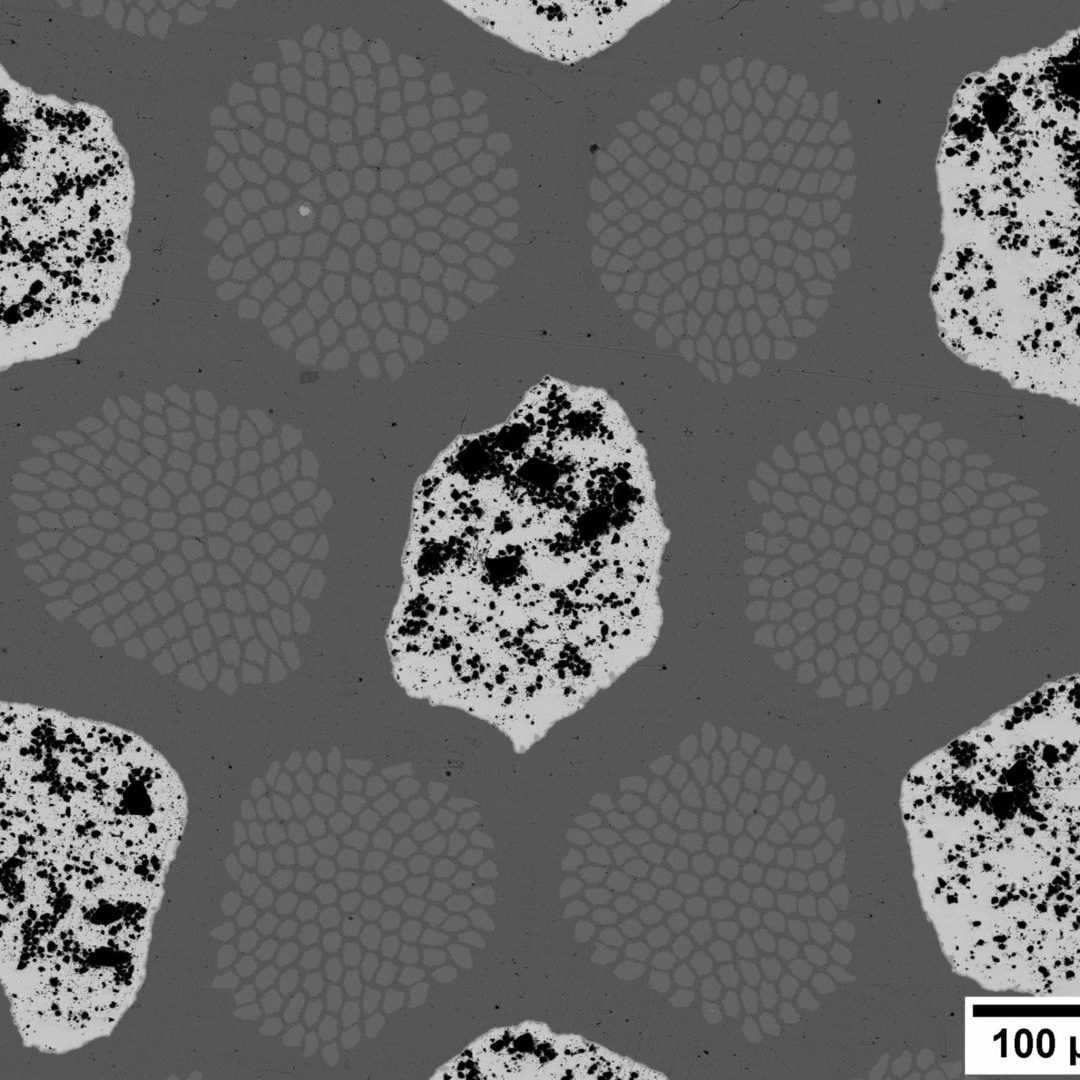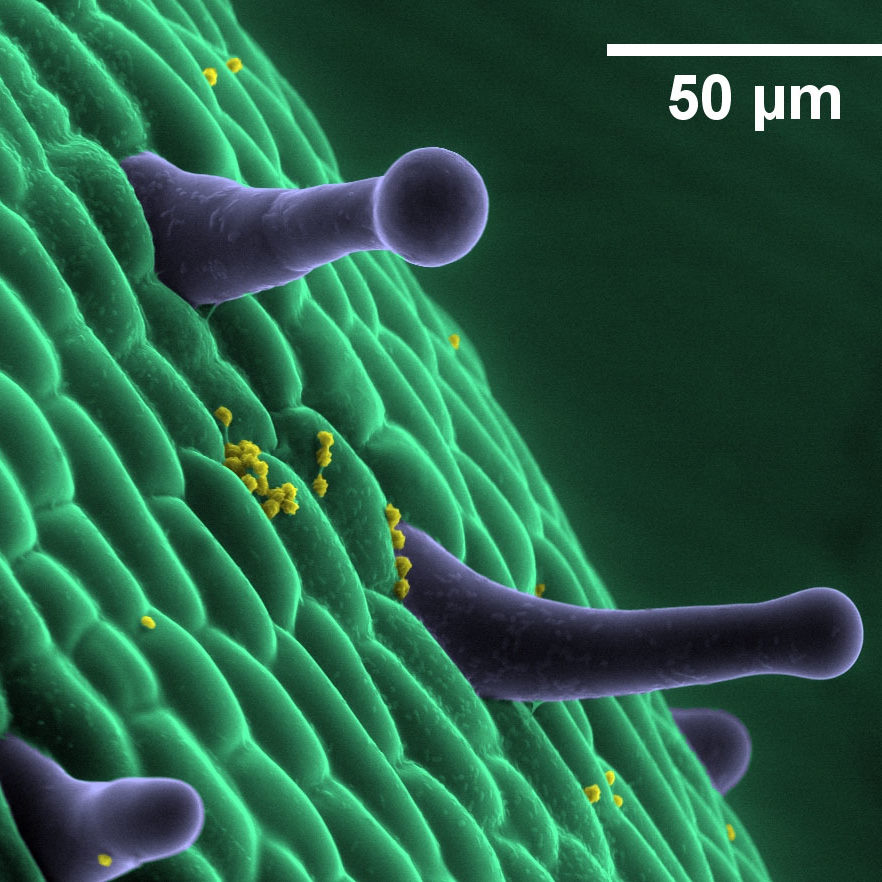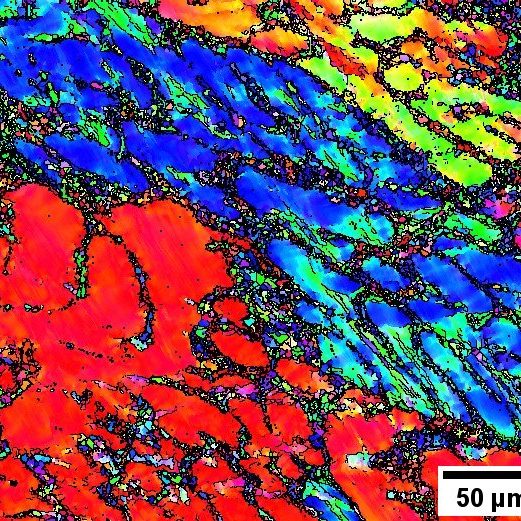The crystallographic structure of materials, as well as their chemical composition and the binding states of the constituent chemical elements are routinely analyzed and visualized in electronic microscopes at atomic, nanometric and micrometric levels. Technological advances over the last few decades also allow the observation and analysis in situ of dynamic phenomena with increasing precision and reproducibility in atomic and nanometric dimensions.
LNNano provides the national and international scientific community with alternatives for accessing a wide range of conventional and advanced techniques of scanning, transmission and double-beam electron microscopy.
Infrastructure
JEOL JEM-2100
Specifications
Transmission electron microscope, with LaB6 electron gun and accelerating voltage of 200 kV, for TEM and STEM modes, with spatial resolutions of 0.25 nm and 1 nm respectively. It has an EDS detector to carry out X-ray spectroscopy mappings by energy dispersion, a brightfield detector for STEM and cameras for recording TEM images of large micrometre or high resolution of large nanometer areas (CMOS, 4kx4k) and electron diffractions. Possibility of using a cryogenic sample holder to analyze samples sensitive to the electron beam, a heating sample holder for in situ analysis increasing the temperature up to 1200 °C and a sample holder for electron tomography.
Techniques
Imaging Modes:
CTEM; HRTEM; BF-TEM; DF-TEM; BF-STEM.
Electron Diffraction Modes:
SAED; NBD; CBED; PDF.
Spectroscopy Class(es):
EDS.
Other available techniques:
In situ heating, electron tomography and cryomicroscopy.
Specifications
Techniques
JEOL JEM-2100
Specifications
Transmission electron microscope, with LaB6 electron gun and accelerating voltage of 200 kV, for TEM and STEM modes, with spatial resolutions of 0.25 nm and 1 nm respectively. It has an EDS detector to carry out X-ray spectroscopy mappings by energy dispersion, a brightfield detector for STEM and cameras for recording TEM images of large micrometre or high resolution of large nanometer areas (CMOS, 4kx4k) and electron diffractions. Possibility of using a cryogenic sample holder to analyze samples sensitive to the electron beam, a heating sample holder for in situ analysis increasing the temperature up to 1200 °C and a sample holder for electron tomography.
Techniques
Imaging Modes:
CTEM; HRTEM; BF-TEM; DF-TEM; BF-STEM.
Electron Diffraction Modes:
SAED; NBD; CBED; PDF.
Spectroscopy Class(es):
EDS.
Other available techniques:
In situ heating, electron tomography and cryomicroscopy.
Specifications
Techniques
JEOL JEM-2100F
Specifications
Transmission electron microscope, with field-effect electron beam and 200 kV acceleration voltage, to operate in TEM and STEM modes, both with 0.19 nm spatial resolution. It has an EDS detector to perform X-ray energy dispersion spectroscopy mappings and an EELS detector to perform electron energy loss spectroscopy mappings with resolutions of 1 eV. It has three different STEM detectors (HAADF, DF and BF), to obtain images according to the atomic number, and CCD cameras for recording images of large or high-resolution micrometric areas and electron diffractions. Possibility of using cryogenic sample holders to analyze samples sensitive to the electron beam.
Techniques
Imaging Modes:
CTEM; HRTEM; BF-TEM; DF-TEM; BF-STEM; ADF-STEM; HAADF-STEM; Lorentz.
Electron Diffraction Modes:
SAED; NBD; CBED; PDF.
Spectroscopy Class(es):
EDS, ELS.
Other Available Techniques:
In situ heating, cryomicroscopy.
Specifications
Techniques
JEOL JEM-2100F
Specifications
Transmission electron microscope, with field-effect electron beam and 200 kV acceleration voltage, to operate in TEM and STEM modes, both with 0.19 nm spatial resolution. It has an EDS detector to perform X-ray energy dispersion spectroscopy mappings and an EELS detector to perform electron energy loss spectroscopy mappings with resolutions of 1 eV. It has three different STEM detectors (HAADF, DF and BF), to obtain images according to the atomic number, and CCD cameras for recording images of large or high-resolution micrometric areas and electron diffractions. Possibility of using cryogenic sample holders to analyze samples sensitive to the electron beam.
Techniques
Imaging Modes:
CTEM; HRTEM; BF-TEM; DF-TEM; BF-STEM; ADF-STEM; HAADF-STEM; Lorentz.
Electron Diffraction Modes:
SAED; NBD; CBED; PDF.
Spectroscopy Class(es):
EDS, ELS.
Other Available Techniques:
In situ heating, cryomicroscopy.
Specifications
Techniques
Thermo Fisher/FEI Titan Cubed Themis
Specifications
Transmission electron microscope double corrected and monochrome, with resolutions up to 0.6 Ångströms and two electron accelerating voltages (80 kV and 300 kV), to operate in TEM and STEM modes and analyze a variety of samples according to their sensitivity to electron beam. It has four EDS detectors to carry out high resolution X-ray spectroscopy mappings by energy dispersion, in a few minutes of collection. It has four different STEM detectors (HAADF, DF-conventional, DF-segmented and BF), to obtain high resolution images according to atomic number or by phase contrast. It also has a 4kx4k CMOS camera, with dynamic recording and two in situ sample holders: one for heating, to increase the temperature from ambient to 1300 °C, specific for samples of nanoparticles and coverslips prepared by FIB; and a liquid cell sample holder to analyze structures and dynamic processes of materials and biological samples in liquid environments, in static mode or in liquid flow.
Techniques
Imaging Modes:
CTEM; HRTEM; BF-TEM; DF-TEM; NCSI-HRTEM (Negative Cs Imaging); BF-HRSTEM; ABF-HRSTEM; ADF-HRSTEM; HAADF-HRSTEM; DPC-HRSTEM; mono-HRTEM; mono-HRSTEM; Lorentz.
Electron Diffraction Modes:
SAED; NBD; CBED; PDF; 4D-STEM.
Spectroscopy Class(es):
EDS as atomic resolution.
Other Available Techniques:
TEM and STEM in situ heating for nanoparticles and coverslips by FIB; TEM and in situ STEM of liquid phases; TEM and STEM electron tomography; cryomicroscopy.
Specifications
Techniques
Thermo Fisher/FEI Titan Cubed Themis
Specifications
Transmission electron microscope double corrected and monochrome, with resolutions up to 0.6 Ångströms and two electron accelerating voltages (80 kV and 300 kV), to operate in TEM and STEM modes and analyze a variety of samples according to their sensitivity to electron beam. It has four EDS detectors to carry out high resolution X-ray spectroscopy mappings by energy dispersion, in a few minutes of collection. It has four different STEM detectors (HAADF, DF-conventional, DF-segmented and BF), to obtain high resolution images according to atomic number or by phase contrast. It also has a 4kx4k CMOS camera, with dynamic recording and two in situ sample holders: one for heating, to increase the temperature from ambient to 1300 °C, specific for samples of nanoparticles and coverslips prepared by FIB; and a liquid cell sample holder to analyze structures and dynamic processes of materials and biological samples in liquid environments, in static mode or in liquid flow.
Techniques
Imaging Modes:
CTEM; HRTEM; BF-TEM; DF-TEM; NCSI-HRTEM (Negative Cs Imaging); BF-HRSTEM; ABF-HRSTEM; ADF-HRSTEM; HAADF-HRSTEM; DPC-HRSTEM; mono-HRTEM; mono-HRSTEM; Lorentz.
Electron Diffraction Modes:
SAED; NBD; CBED; PDF; 4D-STEM.
Spectroscopy Class(es):
EDS as atomic resolution.
Other Available Techniques:
TEM and STEM in situ heating for nanoparticles and coverslips by FIB; TEM and in situ STEM of liquid phases; TEM and STEM electron tomography; cryomicroscopy.
Specifications
Techniques
Thermo Fisher Scientific Quanta 650 FEG
Specifications
Scanning electron microscope with FEG Schottky electron gun and accelerating voltage between 500 V and 30 kV. It allows acquisition of secondary (SE), backscattered (BSE) and transmitted (STEM) electron images, with resolutions of 1.2 nm, 3.0 nm and 0.8 nm respectively. It can operate in high vacuum (HV), low vacuum (LV) and environmental (ESEM) modes, allowing the analysis of a wide variety of metallic, ceramic, polymeric, semiconductor and biological materials, as well as wet, liquid and non-conductive samples. It features detectors for energy dispersive X-ray spectroscopy (EDS), electron backscatter diffraction (EBSD), plasma cleaning to remove carbon contamination and heating device for in situ experiments at temperatures up to 1000 °C.
Techniques
IMAGE ACQUISITION
SE (Secondary Electrons); BSE (Backscattered Electrons); STEM (Transmitted Electrons in Scan Transmission Mode – BF, DF and HAADF).
CHEMICAL ANALYSIS
EDS (Energy Dispersion X-ray Spectroscopy).
CRYSTALOGGRAPHIC ANALYSIS
EBSD (Backscattered Electron Diffraction); TKD (Kikuchi diffraction in transmission mode).
OTHER AVAILABLE TECHNIQUES
LV (Scanning Electron Microscopy in Low Vacuum Mode); ESEM (Scanning Electron Microscopy in Environmental Mode); Heating stage for in situ heating experiments up to 1000 °C; Integrated Plasma Cleaner.
Specifications
Techniques
Thermo Fisher Scientific Quanta 650 FEG
Specifications
Scanning electron microscope with FEG Schottky electron gun and accelerating voltage between 500 V and 30 kV. It allows acquisition of secondary (SE), backscattered (BSE) and transmitted (STEM) electron images, with resolutions of 1.2 nm, 3.0 nm and 0.8 nm respectively. It can operate in high vacuum (HV), low vacuum (LV) and environmental (ESEM) modes, allowing the analysis of a wide variety of metallic, ceramic, polymeric, semiconductor and biological materials, as well as wet, liquid and non-conductive samples. It features detectors for energy dispersive X-ray spectroscopy (EDS), electron backscatter diffraction (EBSD), plasma cleaning to remove carbon contamination and heating device for in situ experiments at temperatures up to 1000 °C.
Techniques
IMAGE ACQUISITION
SE (Secondary Electrons); BSE (Backscattered Electrons); STEM (Transmitted Electrons in Scan Transmission Mode – BF, DF and HAADF).
CHEMICAL ANALYSIS
EDS (Energy Dispersion X-ray Spectroscopy).
CRYSTALOGGRAPHIC ANALYSIS
EBSD (Backscattered Electron Diffraction); TKD (Kikuchi diffraction in transmission mode).
OTHER AVAILABLE TECHNIQUES
LV (Scanning Electron Microscopy in Low Vacuum Mode); ESEM (Scanning Electron Microscopy in Environmental Mode); Heating stage for in situ heating experiments up to 1000 °C; Integrated Plasma Cleaner.
Specifications
Techniques
Thermo Fisher Scientific Inspect F50
Specifications
Scanning electron microscope with FEG Schottky electron gun and accelerating voltage between 500 V and 30 kV. It allows acquisition of secondary (SE), backscattered (BSE) and transmitted (STEM) electron images, with resolutions of 1.0 nm, 2.5 nm and 0.8 nm respectively. It operates only in high vacuum (HV) mode, but allows you to analyze with high resolution a wide variety of materials such as metals, ceramics, polymers and semiconductors. It has a detector for energy dispersive X-ray spectroscopy (EDS).
Techniques
IMAGE ACQUISITION
SE (Secondary Electrons); BSE (Backscattered Electrons); STEM (Transmitted Electrons in Scan Transmission Mode – BF, DF and HAADF).
CHEMICAL ANALYSIS
EDS (Energy Dispersion X-ray Spectroscopy).
Specifications
Techniques
Thermo Fisher Scientific Inspect F50
Specifications
Scanning electron microscope with FEG Schottky electron gun and accelerating voltage between 500 V and 30 kV. It allows acquisition of secondary (SE), backscattered (BSE) and transmitted (STEM) electron images, with resolutions of 1.0 nm, 2.5 nm and 0.8 nm respectively. It operates only in high vacuum (HV) mode, but allows you to analyze with high resolution a wide variety of materials such as metals, ceramics, polymers and semiconductors. It has a detector for energy dispersive X-ray spectroscopy (EDS).
Techniques
IMAGE ACQUISITION
SE (Secondary Electrons); BSE (Backscattered Electrons); STEM (Transmitted Electrons in Scan Transmission Mode – BF, DF and HAADF).
CHEMICAL ANALYSIS
EDS (Energy Dispersion X-ray Spectroscopy).
Specifications
Techniques
Thermo Fisher Scientific Helios NanoLab 660
Specifications
Double-beam electron microscope that combines a scanning electron microscope (SEM) with a focused ion beam microscope (FIB). It has FEG Schottky electron gun with accelerating voltage between 20 V and 30 kV and gallium ion gun with accelerating voltage between 500 V and 30 kV. It allows acquisition of secondary (SE), backscattered (BSE) and transmitted (STEM) electron images, with resolutions up to 0.6 nm. It has a nanomanipulator, immersion lens, monochromator, gas injection system (GIS) for deposition of materials, plasma and cryogenic sample cleaning devices, and detectors for energy dispersive X-ray spectroscopy (EDS) and electron backscattered diffraction (EBSD). It is an extremely versatile equipment that allows analysis with very high resolution (XHR), nano fabrication, preparation of ultra-fine samples for transmission electron microscopy and 3D reconstructions by sequential cuts.
Techniques
SE (Secondary Electrons); BSE (Backscattered Electrons); STEM (scanning transmission electron microscope – BF, DF and HAADF).
CHEMICAL ANALYSIS
EDS (Energy Dispersion X-ray Spectroscopy).
CRYSTALOGGRAPHIC ANALYSIS
EBSD (electron backscatter diffraction); TKD (transmission Kikuchi diffraction).
FIB (FOCUSED ION BEAM) TECHNIQUES.
Nanofabrication and Cross Section Analysis; Deposition of nanostructures (Pt, TEOS, C); Preparation of ultra-fine samples for TEM (FIB-Lamela); 3D reconstructions by sequential cuts (FIB Tomography).
Specifications
Techniques
Thermo Fisher Scientific Helios NanoLab 660
Specifications
Double-beam electron microscope that combines a scanning electron microscope (SEM) with a focused ion beam microscope (FIB). It has FEG Schottky electron gun with accelerating voltage between 20 V and 30 kV and gallium ion gun with accelerating voltage between 500 V and 30 kV. It allows acquisition of secondary (SE), backscattered (BSE) and transmitted (STEM) electron images, with resolutions up to 0.6 nm. It has a nanomanipulator, immersion lens, monochromator, gas injection system (GIS) for deposition of materials, plasma and cryogenic sample cleaning devices, and detectors for energy dispersive X-ray spectroscopy (EDS) and electron backscattered diffraction (EBSD). It is an extremely versatile equipment that allows analysis with very high resolution (XHR), nano fabrication, preparation of ultra-fine samples for transmission electron microscopy and 3D reconstructions by sequential cuts.
Techniques
SE (Secondary Electrons); BSE (Backscattered Electrons); STEM (scanning transmission electron microscope – BF, DF and HAADF).
CHEMICAL ANALYSIS
EDS (Energy Dispersion X-ray Spectroscopy).
CRYSTALOGGRAPHIC ANALYSIS
EBSD (electron backscatter diffraction); TKD (transmission Kikuchi diffraction).
FIB (FOCUSED ION BEAM) TECHNIQUES.
Nanofabrication and Cross Section Analysis; Deposition of nanostructures (Pt, TEOS, C); Preparation of ultra-fine samples for TEM (FIB-Lamela); 3D reconstructions by sequential cuts (FIB Tomography).
Specifications
Techniques



